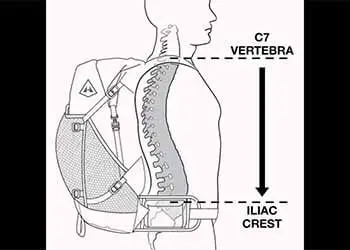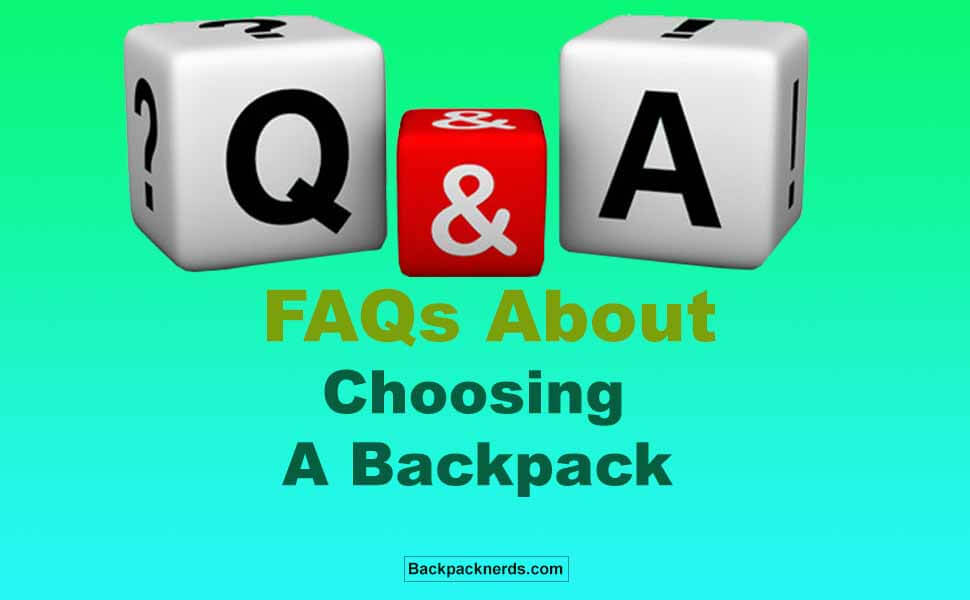A backpack is an essential accessory for anyone who needs to carry items on the go. However, selecting the right backpack can be a daunting task, especially with the plethora of options available in the market. To help you make an informed decision, we have compiled a list of frequently asked questions (FAQs) about choosing a backpack. These FAQs cover everything from size and capacity to materials and features, ensuring that you choose the perfect backpack for your needs.
Related: How to Choose the Right Backpack
FAQs about Choosing a Backpack

Choosing the right backpack is crucial for comfortable and stress-free travels or outdoor activities. With so many options available, it can be overwhelming to select the perfect one. In this article, we have compiled some frequently asked questions to help you make an informed decision when choosing a backpack.
#1. What Are The Types of Backpacks?
There are various types of backpacks available, each designed for specific activities or purposes. Here are some common types with their approximate capacity:
| Backpack Type | Description | Capacity (in liters) |
| Daypack | Small backpacks ideal for day trips, errands, or light hikes | 10-30 |
| Hiking Backpack | Large backpacks with frames for support and hydration systems for hiking and trekking | 30-80 |
| Travel Backpack | Backpacks designed for longer trips and with multiple compartments for organization | 30-60 |
| School Backpack | Backpacks with laptop sleeves and multiple pockets designed for students | 20-30 |
| Tactical Backpack | Rugged backpacks with MOLLE webbing for military or law enforcement use | Varies |
| Cycling Backpack | Compact backpacks with a streamlined design and hydration systems designed for cycling | 5-20 |
When choosing a backpack, consider your activity, duration of use, and the amount of gear you need to carry. This information will help you select the right type of backpack with an appropriate capacity.
Related: Different Types of Backpacks with Images
#2. Backpack Size Guide for School
When it comes to selecting a backpack for school, it’s crucial to pick the right size. Ideally, a school backpack should be between 20-30 liters, large enough to carry textbooks, binders, and other essentials, but not too bulky or heavy for everyday use. Additionally, look for backpacks with features such as padded straps and back panels for added comfort during long days at school.
Related: Backpack Size Guide
#3. How to Choose a Backpack for School?
When choosing a backpack for school, consider the following factors: size, durability, comfort, and organization. Select a backpack that can comfortably fit all your textbooks, binders, and other essentials. Look for durable materials and sturdy construction to withstand daily wear and tear. Additionally, choose a backpack with padded straps and back panels for added comfort during long days at school. Lastly, opt for a backpack with multiple pockets and compartments to keep your belongings organized and easily accessible.
#4. What Is Backpack Size Calculator?
To ensure that you select the right size backpack, you can use a backpack size calculator. These calculators consider your height, weight, and torso length to recommend a backpack size. Some calculators may also consider the type of activity you plan to use the backpack for. It’s important to note that a backpack size calculator is just a guide, and you should also consider your specific needs and preferences when selecting a backpack.
#5. How To Calculate Backpack Size Dimensions From Cubic Inch To Cubic Liters?
To convert backpack size from cubic inches to cubic liters, you can use the following formula:
Cubic Liters = Cubic Inches ÷ 61.02
Here’s a table that shows the conversion of common backpack sizes:
| Cubic Inches | Cubic Liters |
| 1000 | 16.39 |
| 2000 | 32.78 |
| 3000 | 49.17 |
| 4000 | 65.56 |
| 5000 | 81.95 |
For example, if you have a backpack with a volume of 4000 cubic inches, the backpack’s size in cubic liters would be:
Cubic Liters = 4000 ÷ 61.02 Cubic Liters = 65.56
Therefore, the backpack size is approximately 65.56 liters.
#6. What Is Backpack Size Chart Liters?
A backpack size chart in liters is a reference guide that provides the volume range of backpacks in liters. This chart is useful when selecting a backpack to ensure that you choose the appropriate size for your needs. Backpack size charts typically categorize backpacks by type, such as daypacks, hiking backpacks, or travel backpacks, and provide a range of liter volumes for each type.
#7. What Size Backpack for Day Hike?
When it comes to selecting a backpack for a day hike, a backpack with a volume of 20-30 liters is generally sufficient. This size can accommodate essentials such as water, snacks, extra clothing layers, and first aid kits. It’s important to choose a backpack with padded shoulder straps and a waist belt to distribute weight evenly and provide comfort during the hike.
#8. How to Measure Torso for a Backpack?

To measure your torso length for a backpack, follow these steps:
- Find the C7 vertebrae at the base of your neck, which is the bony protrusion that sticks out when you tilt your head forward.
- Using a flexible measuring tape, place one end at the base of your neck at the C7 vertebrae and extend the tape down your spine to the top of your hip bones. This is your torso length measurement.
- Compare your torso length measurement with the manufacturer’s sizing chart to determine which backpack size is best for you.
It’s important to note that backpacks come in different sizes to accommodate different torso lengths, and selecting the correct size is crucial for proper weight distribution and comfort during extended use.
#9. How to Measure Your Waist for Choosing a Backpack?
When selecting a backpack with a waist belt, it’s important to measure your waist to ensure proper fit. Follow these steps to measure your waist for a backpack:
- Locate your hip bones and find the top of your iliac crest, which is the uppermost part of your hip bone that sticks out.
- Wrap a flexible measuring tape around your waist at the level of your iliac crest, making sure the tape is snug but not too tight.
- Note your waist measurement and compare it to the manufacturer’s sizing chart to determine which backpack size is best for you.
Choosing a backpack with a properly fitting waist belt is essential for distributing weight and providing comfort during extended use. A well-fitted waist belt should sit comfortably on your iliac crest and not ride up or down when you move.
Related: How to Fit Your Backpack Properly
#10. How to Choose the Right Backpack?

To choose the right backpack, consider the following factors:
- Purpose: Determine the backpack’s intended use (e.g., hiking, school, travel) to select a suitable type and size.
- Fit: Make sure the backpack fits properly and comfortably by measuring your torso and waist and comparing it to the manufacturer’s sizing chart.
- Features: Look for features such as padded straps, a waist belt, multiple compartments, and water-resistant materials to meet your specific needs.
- Brand and Price: Choose a reputable brand with a good reputation for quality and durability. Set a budget that aligns with your needs and preferences.
- Quality and Durability: Choose a backpack from a reputable brand with a history of producing high-quality and durable products.
By taking these factors into account, you can select the right backpack that meets your needs, fits comfortably, and provides the necessary features for your intended use.
Related: How to Wear a Backpack Properly
#11. What Should Be My Budget To Pick A Backpack?
The budget for a backpack can vary depending on the intended use and personal preferences. For example, a basic backpack for school use may cost between $20 to $50, while a high-quality backpack for hiking or travel can cost upwards of $100 or more.
When selecting a backpack, it’s important to balance quality, features, and cost. Choosing a reputable brand and investing in a high-quality backpack can save money in the long run by lasting longer and providing better functionality.
Ultimately, your budget for a backpack should align with your intended use, personal preferences, and financial situation. It’s important to determine your needs and shop around to find a backpack that meets your requirements and fits within your budget.
#12. What Should Be The Questions Before Buying A New Backpack?
Yes, these are some important questions to consider before buying a new backpack:
- What is my budget for a backpack?
- Why do I need a backpack? What is the intended use?
- Where will I use the backpack? Will it be for outdoor activities or urban settings?
- How often will I use the backpack? Will it be for daily use or occasional trips?
- Do I need to worry about pickpocketing or security? If so, consider a backpack with anti-theft features or a hidden pocket.
By answering these questions, you can narrow down your options and find a backpack that fits your needs, preferences, and budget.
#13. What Kind of Backpack Should I Buy?
The type of backpack you should buy depends on your intended use, personal preferences, and budget. If you need a backpack for school, you may want a smaller-sized backpack with multiple compartments for organization. For outdoor activities, such as hiking, you may want a backpack with a larger capacity, water-resistant material, and adjustable straps for comfortable carrying.
When selecting a backpack, consider factors such as size, fit, comfort, features, and durability. Look for a backpack from a reputable brand with a history of producing high-quality and durable products. Additionally, consider your budget and balance quality, features, and cost to find a backpack that meets your needs and fits within your budget.
Ultimately, the best type of backpack to buy is one that meets your specific needs and preferences, and provides the necessary features and functionality for your intended use.
#14. Does Capacity Play a Major Role?
Yes, the capacity of a backpack plays a major role in determining its suitability for a particular use. A backpack’s capacity determines how much gear and supplies you can carry. When selecting a backpack, consider the activities you plan to use it for and choose a capacity that meets your needs. A backpack that is too small may not be able to carry all your necessary items, while a backpack that is too large may be heavy and cumbersome to carry.
#15. What Features Do I Want on My Backpack?
The features you want on your backpack will depend on your intended use and personal preferences. Some common features to consider include:
- Compartments and pockets for organization
- Padded straps and back panel for comfort
- Water-resistant or waterproof materials for outdoor use
- Sternum strap and waist belt for weight distribution
- Compression straps for adjusting the volume of the backpack
- Hydration system compatibility for outdoor activities
- Built-in rain cover for protection from the elements
When selecting a backpack, prioritize the features that are most important to your intended use and consider your budget to find the best balance between functionality and cost.
#16. What Size Backpack for Travelling?
The size of a backpack for traveling will depend on the duration of your trip, the type of activities you plan to do, and personal preferences.
For a weekend getaway or a short trip, a backpack with a capacity of 30-40 liters may be sufficient. For longer trips or backpacking expeditions, a backpack with a capacity of 50-70 liters may be necessary to carry all your gear.
It’s important to consider the weight and size of your backpack to ensure it meets airline carry-on restrictions if you plan to travel by plane. Additionally, adjustable straps, padded hip belts, and ventilation are important features to consider for comfortable and convenient travel.
Related: How Big Is a 30 Liter Backpack
#17. What Size Backpack for Day Hike?
For a day hike, a backpack with a capacity of 20-30 liters is typically sufficient. This size should accommodate the essential items you need for a day hike, such as a water bottle, snacks, a first aid kit, extra layers, and sunscreen. It’s important to choose a backpack with padded straps and a comfortable back panel to minimize discomfort during the hike. Additional features to consider may include exterior pockets for easy access to essentials, hydration system compatibility, and compression straps to keep your gear in place. Ultimately, the size of your backpack will depend on your personal needs and preferences, as well as the length and difficulty of the hike.
Related: How Big is a 20 Liter Backpack?
#18. What Are The Best Backpack For 3 Day Hike?
When it comes to finding the best backpack for a 3-day hike, there are a number of factors to consider, including capacity, comfort, and price. A backpack with a capacity of 40-60 liters is typically a good choice for a 3-day hike, as it should provide enough space for your gear without being too bulky or heavy. Some popular backpacks for this purpose include the Osprey Atmos AG 50 (around $250), the Deuter Aircontact Lite 60+10 (around $200), and the Gregory Baltoro 65 (around $300). These backpacks are designed for comfort, with padded straps and back panels, and feature convenient pockets and compartments for organization. While they may be a bit pricier than other options, their durability and functionality make them a worthwhile investment for serious hikers.
Related: How Big is a 40 Liter Backpack
#19. What Are The Average Backpack Size Inches?
The average backpack size in inches can vary depending on the intended use and capacity of the backpack. However, backpacks typically range in size from 15 inches in height for smaller daypacks up to 24 inches or more for larger backpacks used for travel or extended outdoor trips. The width and depth of a backpack can also vary, typically ranging from 6-12 inches in width and 3-8 inches in depth. It’s important to note that these are just general measurements and can vary by brand and model.
#20. What Things to Consider When Looking For the Best Backpack Size for You?
When looking for the best backpack size for you, there are a few things to consider:
- Purpose: What will you be using the backpack for? The size you need will vary depending on whether you are using it for everyday commuting, hiking, or travel.
- Capacity: How much stuff do you need to carry? Make sure you choose a backpack with enough capacity to fit all of your essentials comfortably.
- Torso length: Consider the length of your torso to ensure a proper fit. Measure from the base of your neck to the top of your hips to determine your torso length.
- Waist size: If your backpack has a waist belt, make sure it fits properly and comfortably around your waist.
- Comfort: Look for a backpack with padded straps and back panels to ensure comfort, especially if you plan to use it for extended periods of time.
- Durability: Consider the quality of the backpack’s materials and construction to ensure it will hold up over time.
- Brand and price: Look for reputable brands that offer quality backpacks at a price that fits your budget.
By following these factors you can find the best backpack for you. At least you can narrow down your choice and preferences. You can choose the right backpack if you follow the above factors. Know more.
Final Words
In conclusion, when it comes to choosing the right backpack, there are many factors to consider. From understanding the different types of backpacks available to measuring your torso and waist, there are many resources and tools available to help you make an informed decision. By answering the FAQs about choosing a backpack and considering factors such as capacity, durability, comfort, and price, you can find a backpack that suits your needs and preferences perfectly. Whether you’re using your backpack for daily commutes, outdoor adventures, or travel, selecting the right backpack can make a world of difference in your comfort and enjoyment.

